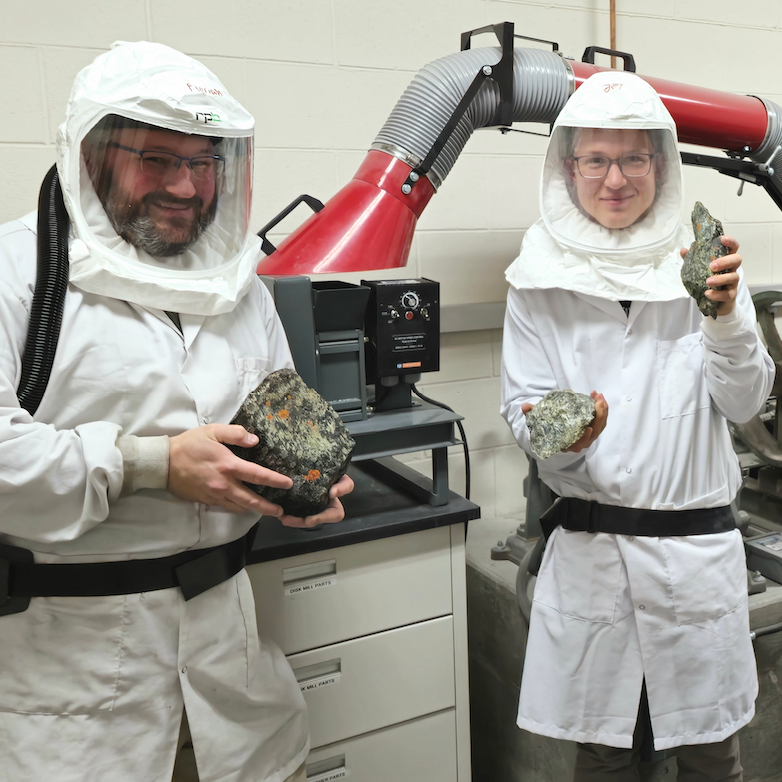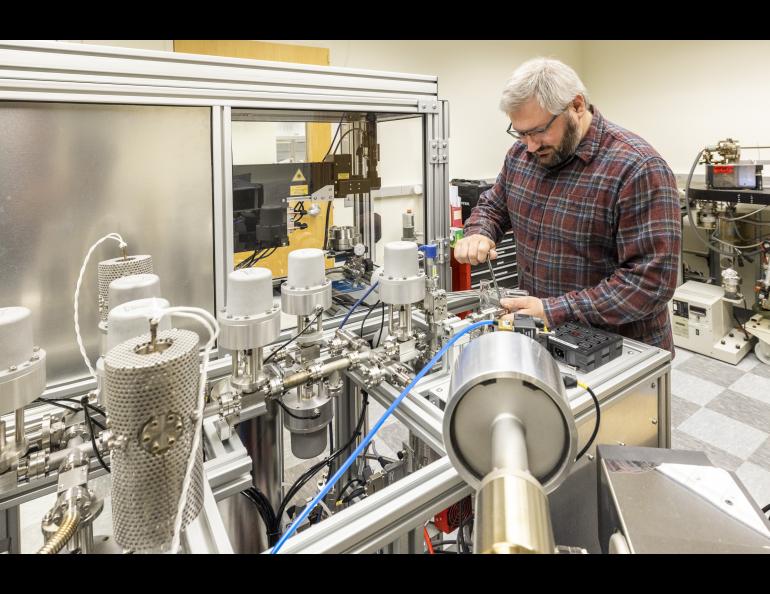
The Geochronology Laboratory at the Geophysical Institute of the University of Alaska Fairbanks is a state-of-the-art 40Ar/39Ar facility that determines ages of rocks and minerals. The Geochron Lab is located on the third floor of the Reichardt Building (Room 369) on the Troth Yeddha' (Fairbanks) campus. The facility is available for analysis requests. For interest, please contact the Geochron Lab staff. For an introduction to the lab, see this recent Instagram video.
The Geophysical Institute has housed a facility for geochronology since the initial K-Ar facility was established by Don Turner in 1971. This system was converted to 40Ar/39Ar by Paul Layer in 1990 and replaced with a VG-3600 mass spectrometer in 1994. A new Isotopx NGX-600 multi-collector mass spectrometer has been taken into operation in June 2023. This system features a CO2 laser and a low-blank resistance furnace for argon extraction.
- How it works
The 40Ar/39Ar method
We use the 40Ar/39Ar method to measure the ages of rocks and minerals. Most rocks and minerals contain potassium, a small amount of which (about 0.01%) is the radioactive isotope 40K. Over time, this isotope decays to 40Ar (and 40Ca) with a half-life of 1.25 billion years. By measuring the remaining 40K and the amount of 40Ar produced by radioactive decay, we can calculate the age of a rock.
Measuring both a gas (40Ar) and a solid (40K) introduces uncertainty into the process. To improve the dating accuracy, we irradiate samples with neutrons in a nuclear reactor which transforms some of the main potassium isotope, 39K, into 39Ar. Since both 39Ar and 40Ar are gases, we can measure them at the same time with a single method. This technique, called the 40Ar/39Ar method, improves our measurements and enables us to obtain very precise ages.
Mineral separation and age determination
When analyzing rocks, we typically focus on a specific mineral within the rock or, in the case of volcanic rocks, the fine-grained groundmass. The rock samples are first broken up and crushed to separate the individual mineral grains. The crushed material is then sieved to a specific grain size and subjected to separation methods that sort the mineral grains based on their density, magnetic properties, and other characteristics. Under a light microscope, we select individual grains for further analysis.
We then send the chosen grains to the nuclear research reactor at Oregon State University where they are bombarded with neutrons. This process transforms some of the 39K to 39Ar. Subsequently, the samples are sent back to the Geochron Lab, where we heat them either using a furnace or a laser to release the gases contained within. The argon is separated from the other gas components, and all of the five main argon isotopes (36Ar, 37Ar, 38Ar, 39Ar, and 40Ar) are measured using a mass spectrometer. Some amounts of all of these isotopes are produced in the irradiation, so we measure them all (as opposed to just 39Ar and 40Ar) to improve the measurement. To determine the age of the analyzed sample, we compare the 40Ar/39Ar measurements with those of a standard with a known age.
Applications
The 40Ar/39Ar technique finds various applications, such as measuring the ages of volcanic rocks. When rocks are hot, argon diffuses out of them, preventing the accumulation of argon within the rock. Since volcanic rocks are erupted while still hot, they do not contain any argon initially, but they do contain potassium. As these rocks cool rapidly after the eruption, they can retain all the argon produced from the decay of 40K. Therefore, the measured age corresponds to the time elapsed since the eruption. This method helps determine the ages of volcanic and sedimentary rocks, contributing to our understanding of volcanoes, the evolution of life over geological time, and the movement of tectonic plates.
Argon can also be used to study rocks that have cooled gradually over time. At great depths within the Earth, rocks are hot enough to lose all the argon produced by the radioactive decay of 40K. However, as these rocks move closer to the Earth's surface due to processes like mountain-building and erosion, they gradually cool. Before the rock reaches a temperature at which argon is no longer lost, it experiences a range of temperatures at which argon is partially lost. Only when low temperatures are reached can 40Ar fully accumulate within the crystal. The ages of samples that have undergone this process do not indicate a specific point in time but rather are a product of the temperature changes that the rock has experienced. We called this kind of data “cooling ages”. We can reconstruct the temperature history of a sample from such cooling ages using computer modeling. This method of thermochronology helps us to study how mountain ranges form and how fast they are eroded.
- Equipment
40Ar/39Ar dating system We are fully equipped to produce 40Ar/39Ar ages from rock samples. The equipment of the Geochron Lab covers rock crushing, mineral separation, sample picking, sample characterization, handling of irradiated samples, Ar isotope measurement, and data reduction.
- Isotopx NGX-600 multi-collector noble gas mass spectrometer with a collector configuration optimized for argon (nine Faraday cups with ATONA amplifiers and one ion-counting electron multiplier). The new instrument was purchased with funds from National Science Foundation Major Research Instrumentation grant #2019235 and the Geophysical Institute.
- Preparation line with two GP50 SAES getters (reactive surfaces that help reduce certain gas components) and a liquid nitrogen trap for gas purification
- Teledyne Photon Machines Fusions CO2 laser stepped heating system (100 W, 10600 nm)
- Pond Engineering TC-9 Low Blank Furnace
- PolyScience IP-100 Immersion Probe Cooler
- Norhof #905 automatic LN2 micro-dosing system
- Eaton 9PX 6k UPS (uninterruptible power supply)
- Pychron data processing and reduction software


The new Isotopx NGX mass spectrometer being installed (October 2022). Mineral separation
- Two rock saws
- Two jaw crushers
- Disk mill
- 8” and 3” test sieves and sieve shakers
- Three Frantz isodynamic magnetic separators
- Density separation equipment using LST (lithium heteropolytungstate) and SPT (sodium polytungstate)
- Vacuum oven and natural convection oven for drying samples
Sample characterization
- Reflected and transmitted light microscopes for sample picking and documentation
- Thermo Scientific Nicolet Summit Pro Attenuated Total Reflection Fourier Transform Infrared Spectrometer (ATR-FTIR) for phase identification
- Computer for analyzing and visualizing microCT data
- Services
We offer 40Ar/39Ar dating services, including step-heating, single-aliquot total fusion, and high-resolution diffusion experiments. We can also perform all necessary mineral preparation, picking, and sample characterization. We support the AGeS initiative and welcome outside collaborators to the Geochron Lab for sample analysis. Our commitment includes offering comprehensive training and expert guidance to all visiting individuals across every phase of the process, from sample processing, mineral separation, and picking, to sample analysis, data reduction, and interpretation.
The Geochron Lab is also part of UAF’s Alaska Critical Minerals Collaborative (ACMC) which supports research collaborations with industry, agency, and academic partners.
For questions or interest, please send an email to UAF-Geochron@alaska.edu.
Shipment address:
Florian Hofmann
Reichardt 369
University of Alaska Fairbanks
1930 Yukon Drive
Fairbanks, AK 99775
USAAfter shipping samples, please provide us with the tracking number so that we know to look out for the package.
Please use the UStore to pay Geochron Lab invoices: https://bit.ly/UAF-Geochron-
Lab-pay - Personnel

Florian Hofmann
Research Assistant Professor
Geophysical Institute, University of Alaska Fairbanks
Office: Reichardt 328
fhofmann@alaska.eduFlorian Hofmann manages the day-to-day operations of the UAF Geochron Lab, including preparing and analyzing rock samples, developing and implementing measurement protocols, and training new users. His background is in noble gas geochemistry and geochronology as well as structural geology, tectonics, and surface processes. Florian completed BSc and MSc degrees at the University of Munich, and a PhD at Caltech. He was a Visiting Professor at the University of Munich and a postdoc at Caltech, the University of Southern California, and UAF before being hired as a Research Assistant Professor at the Geophysical Institute in 2023. His research uses high-precision geochronology and thermochronology to study the long-term history of fault zones, the timing of volcanic eruptions, and orogenic processes, with field areas in Alaska and beyond. He is also working on improving the precision and accuracy of geochronologic techniques and developing new target phases for the 40Ar/39Ar method.
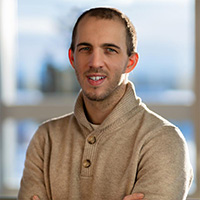
Sean Regan
Associate Professor
College of Natural Science and Mathematics and Geophysical Institute
University of Alaska Fairbanks
sregan5@alaska.eduSean Regan has a broad background in geochronology, with most emphasis given to U–Th-Pb systematics of a wide array of chronometers (monazite, zircon, rutile, apatite, and columbite) and has helped oversee the new Noble Gas Mass Spectrometer at the Geophysical Institute. His background is broadly in igneous and metamorphic petrology, ductile structure, and critical minerals systems. Sean has a BSc from St. Lawrence University, and an MSc and PhD from the University of Massachusetts Amherst, where he worked extensively on petrochronology of high-grade gneiss terranes. After briefly working as a research geologist at the US Geological Survey, Sean accepted an Assistant Professor position at the University of Alaska Fairbanks in 2018 and joined the Geophysical Institute in 2020. His current research covers a broad range of topics including structural evolution of the Denali fault, magma transport and emplacement, and multi-phase geochronology of Critical Mineral systems.
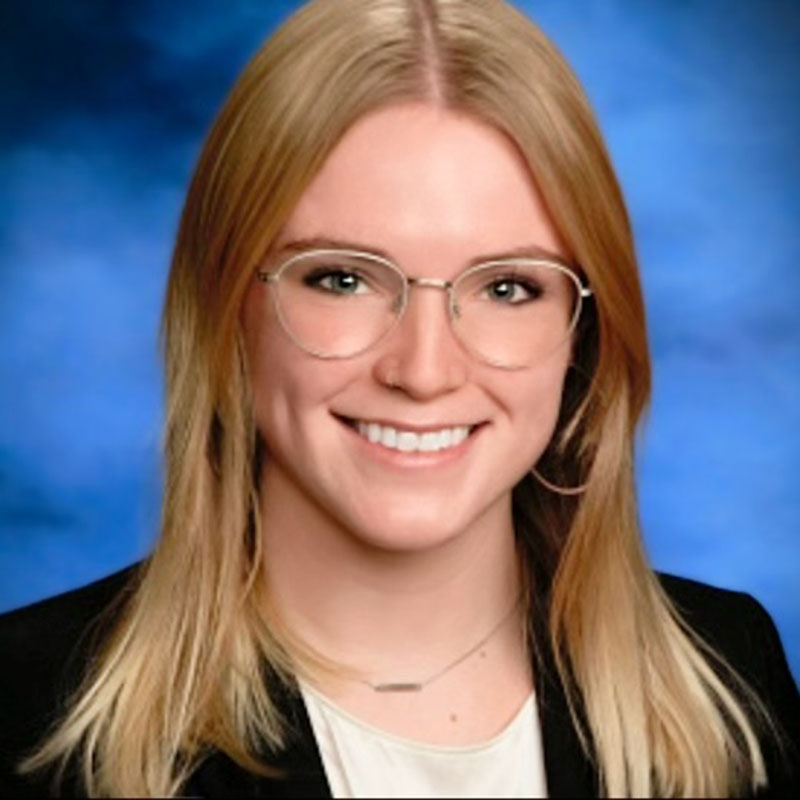
Indie Talbot
Graduate studentIndie is a graduate student pursuing her MSc in economic geology with research interests in geochronology, geochemistry, and petrology. She completed her BSc at St. Lawrence University where her primary research focused on applying olivine-melt thermometry and hygrometry to basalts from the Canary Islands to identify the origin of low Mg# alkaline melts. She began her MSc at UAF in Fall of 2024, where her current research involves utilizing geochemistry and geochronology to identify the sources of mineralizing fluids spatially and temporally that led to the formation of the Manh Choh Au deposit in Tok, Alaska.
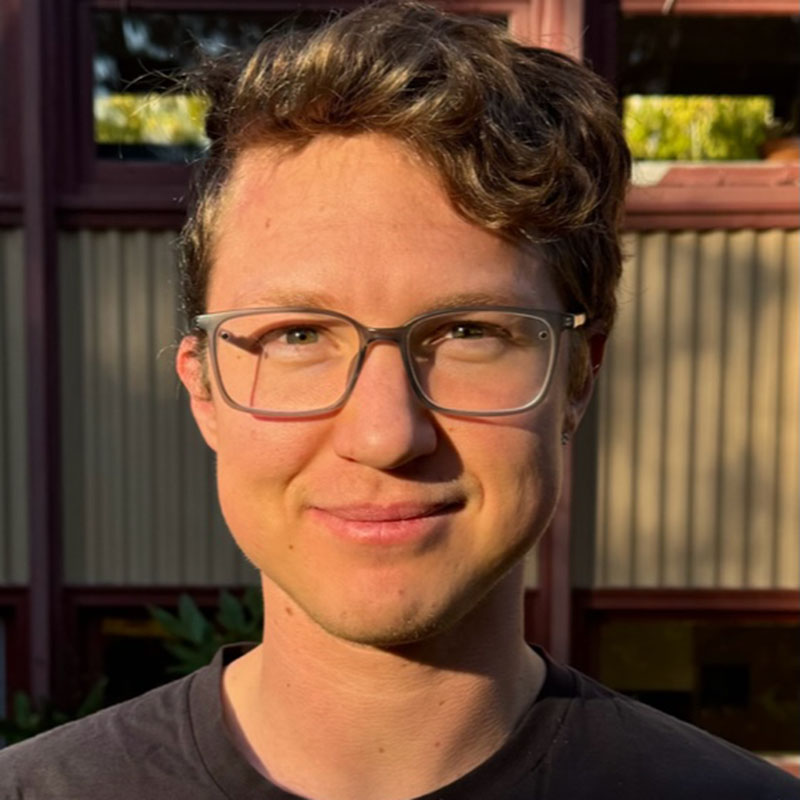
Lee Aeo
Undergraduate StudentLee is an undergraduate student who processes and prepares samples for irradiation and assists with mass spectrometry. Lee is currently researching cosmogenic 3He dating methods to determine high-latitude erosion rates of mafic and ultramafic rocks in order to predict CO2 drawdown rates in the Arctic.
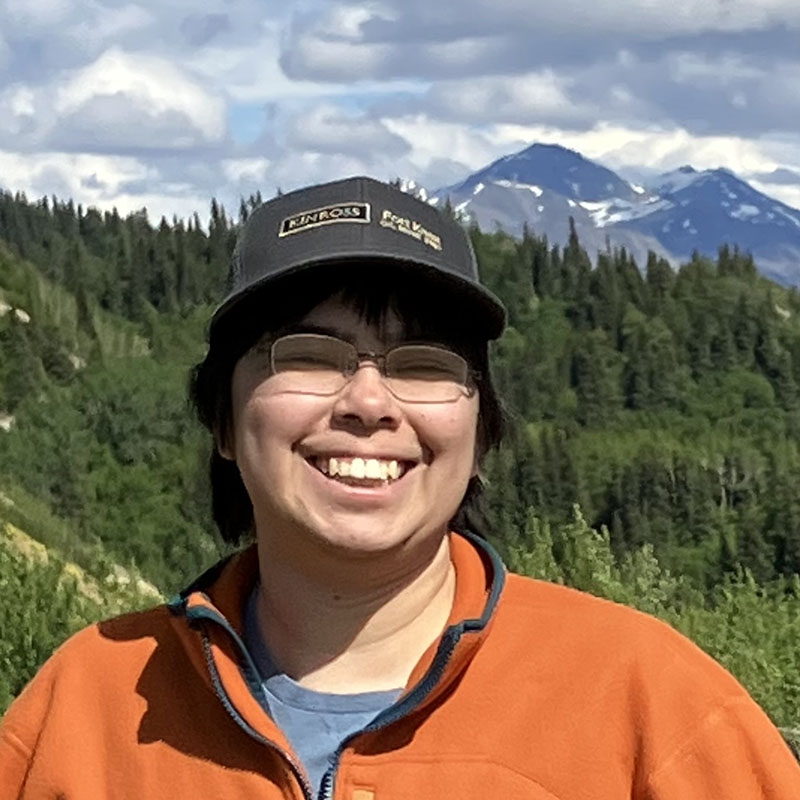
Ada Causey
Undergraduate StudentAda Causey is a senior geology undergraduate at UAF with an interest in igneous petrology and geochronology. Currently, they are working on an URSA project to obtain ages from Unalaska rocks using 40Ar/39Ar dating.
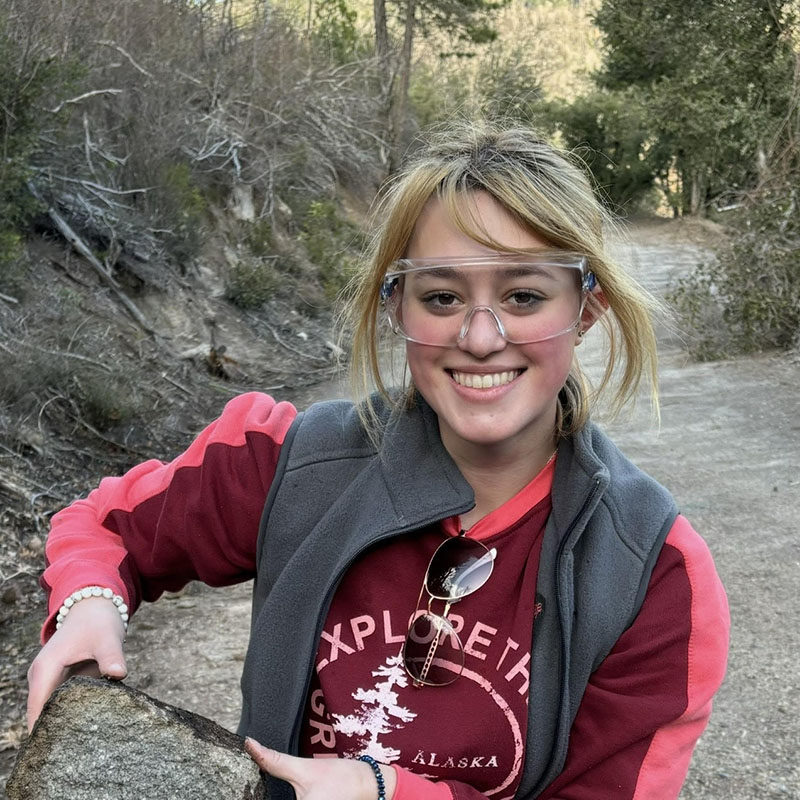
Cori Patchkofsky
Undergraduate StudentCori is a sophomore studying Geoscience and concentrating in Geology. Her scientific interests include dating rocks from volcanos in Alaska. She is currently working on an URSA alongside Florian and Ada on dating young volcanic rocks from Makushin volcano on Unalaska.
- Projects
Current Projects
- Long-term offset history of major continental strike-slip faults (Denali fault, San Andreas fault)
- Modeling of exhumation derived from multiple thermochronometric systems
- Extrusive ages of young volcanic rocks
- Precise dating of impact events
- History of the Geochronology Laboratory
Donald Turner (1970-1989)
Don Turner established the geochronological facility at UAF in 1970 by building a laboratory for K-Ar dating. He installed a custom-built Nuclide Corporation 6-60-SGA (6-inch radius) mass spectrometer, which went into operation in December 1971. Argon was released by heating the sample in an RF fusion system. Parts of this process were automated and allowed for the processing of three samples simultaneously. The gas was cleaned by reacting it with a Cu-CuO furnace, Ti getter, and zeolite. The measurement was done by isotope dilution with a pure 38Ar tracer. Peak heights were measured on a Faraday cup using the peak hopping technique.
Data were acquired with a digital voltmeter, and the averaged voltages were written to punch cards. The lab featured an Interdata computer that was able to evaluate data during the analysis for instant monitoring of the mass discrimination. Bulk potassium concentrations were then measured on the same material with an Instrumentation Labs 343 digital flame photometer using the LiBO2 flux fusion technique. The combined K and Ar data was reduced to ages with a custom program on an IBM 360 computer. The data processing and sample handling systems were updated in 1985 to include more automation.
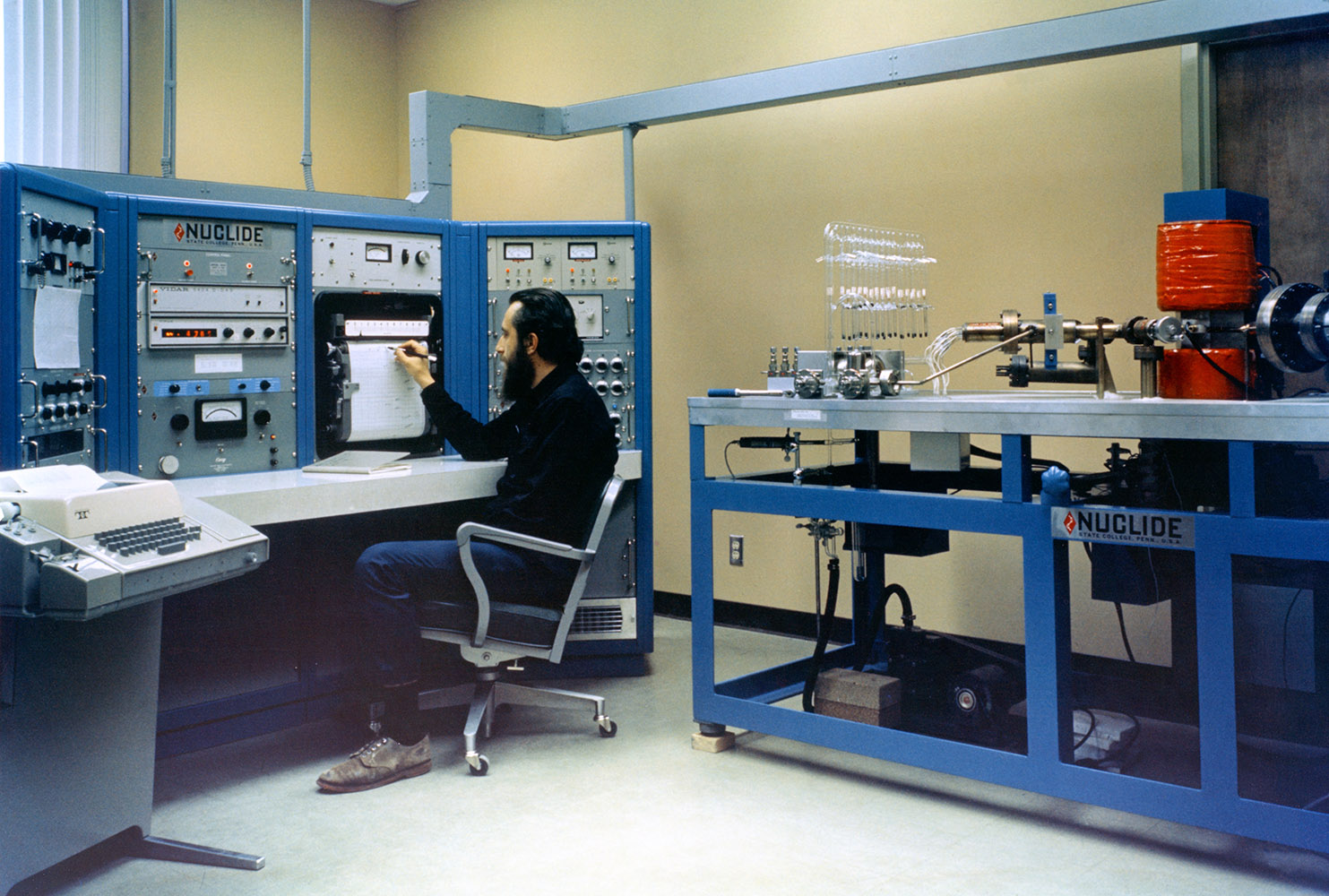
Don Turner operating the mass spectrometer in 1971. Work in the laboratory included establishing absolute ages for igneous, metamorphic, and sedimentary rocks. Don Turner and his students spent many field seasons across Alaska and beyond, collecting rock samples for which they measured K-Ar ages. Examples of this work include studying the complex metamorphic history of the Brooks Range (Turner et al., 1979), determining the timing of movement on the Denali Fault (Warhaftig et al., 1975), exploring the volcanic history of the Aleutian Arc (Nye and Turner, 1990) and dating ash layers in coal beds, which established stratigraphic dates important for evaluating economic potential (Turner et al., 1977, 1980, 1983). Turner et al. (1982) tested the hot spot hypothesis, which is an important part of the theory of plate tectonics, by measuring K-Ar ages of several islands in the Cook-Austral Islands chain, the oldest in the Pacific Ocean. Don Turner retired in 1989 and passed away in 2014.
Paul Layer (1989-2020)
Paul Layer became Don Turner’s successor in the geochronology laboratory in 1989. He modified the existing equipment in order to enable measurements with the 40Ar/39Ar technique. In 1992, he was awarded an NSF grant (#9214375) to purchase and install a new VG3600 mass spectrometer with a Coherent 6-watt argon-ion laser and a Modifications Ltd. resistance-type furnace, which became operational in May 1994. The laser system, which was one of the first of its kind, was fully custom-built and featured a system of lenses, mirrors, and filters on an optical bench, which focused the laser beam onto a sample under a light microscope. Sample heating was monitored with a CCTV camera mounted to the microscope. The resulting gas was purified using a liquid nitrogen cold trap and two SAES Zr-Al getters and then inlet into the VG3600 mass spectrometer, where it was measured by peak hopping on a Faraday cup or Daly detector. The gas handling, data acquisition, and reduction were automatically controlled by a computer. The mass spectrometer electronics were upgraded in 2004, which led to an improvement in signal stability and analytical uncertainties.
Prior to his appointment at UAF, Paul Layer had demonstrated that 40Ar/39Ar age-spectra could be obtained by laser heating (Layer et al., 1987). He built the system at UAF to his specifications in order to explore this new technique. Geological research, often involving students, was focused on dating applications for understanding plutonism, metamorphism, and mineralization in Alaska, the Lower 48, and many countries around the world. Work in Alaska was done in close cooperation with state and federal agencies, as well as exploration and mining companies. Paul Layer also maintained many international collaborations, including with researchers in Mexico, Ukraine, Senegal, Russia, Germany, Argentina, Australia, Canada, and Sweden, leading to samples from all continents being analyzed here. In addition, the Geochronology Laboratory accepted outside sample analysis requests, including mineral separation, laser total fusion, and laser or furnace step-heating analyses. Typically, over 2,000 separate mass spectrometry analyses were performed on this system every year.
Some of the most significant research during this time includes establishing the age of the El’gygytgyn crater from impact-related volcanic rocks (Layer, 2000). The sediments accumulated in Lake El’gygytgyn since the impact represent the most complete Arctic continental climate record, spanning the entire Quaternary. Other prominent studies include providing a temporal framework for reconstructing the history of the Earth’s magnetic field over the last 5 million years (Stone and Layer, 2006; Johnson et al., 2008), exploring Alaskan gold deposits (McCoy et al., 1997) and elucidating the geologic history of regions across Earth (Layer et al., 2001; Ring and Layer, 2003; etc.).

Paul Layer in front of the VG3600 mass spectrometer in 1995. - News & Announcements
Congratulations to Lee Aeo for receiving a 2024 URSA Climate Change Project Award! He will work on using cosmogenic 3He in magnetite to derive erosion rates in Interior Alaska to constrain CO2 drawdown rates in the Arctic.
https://www.uaf.edu/ursa/funding/climate_change_awards/index_climatechangeaward.php
Congratulations to Ada and Cori for receiving a 2024 URSA Fall Project Award! They will be working on 40Ar/39Ar dating of volcanic rocks from the Aleutians..
https://www.uaf.edu/news/ursa-announces-2024-fall-student-project-award-recipients.php

